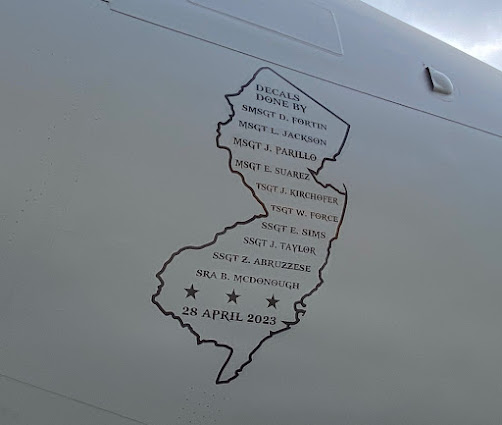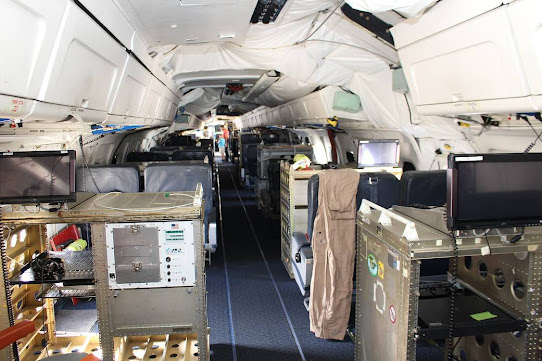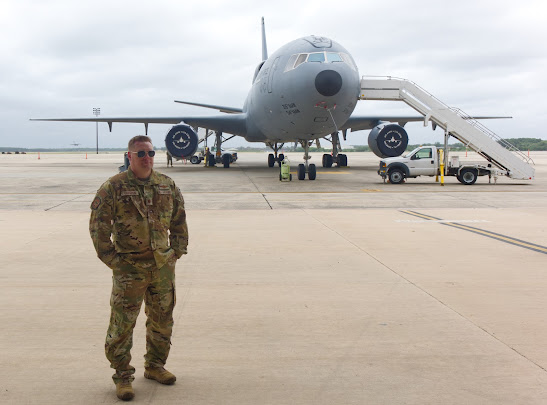Its attractive design unmistakable, aircraft 84-0188 is
prepared by McGuire team members for the refueling jet’s flight into retirement
at Davis-Monthan Air Force Base in Arizona – the
last of the New Jersey base’s fleet of McDonnell-Douglas KC-10 Extender
refueling planes.
“Anybody you talk to about
the KC-10 – pilot, flight engineer, boom operator, maintainer – there’s
definitely a pride about this airplane, that it was very special. Most of us
feel that the KC-10 has several more years, even decades, left in her. That
she’s being retired before her time is what I think hurts most in the crew
force…”
Lt. Col. Adam Waite was speaking
about the imminent retirement of the unique three-engine McDonnell-Douglas KC-10
Extender refueling/cargo aircraft, a plane with a curvaceous profile that
generated the humorous descriptor “Big Sexy.”
Waite’s words came with a
definite hint of sadness. It was June 21, 2023, and the very next day the last
KC-10 assigned to Joint Base McGuire-Dix-Lakehurst in New Jersey would take to
the skies a final time, bound for what will essentially be interment at the “Boneyard”
– Davis-Monthan Air Force Base in Arizona.
In a final moment of public glory, the KC-10 nicknamed
“Armadillo Express” roars over tens of thousands of people gathered for 2023’s
“Power in the Pines” airshow at Joint Base McGuire-Dix-Lakehurst.
Waite – on the verge of retiring
as a military pilot - knew well of what he spoke, for he himself had recently
flown the next-to-the-last of McGuire’s KC-10s (an aircraft nicknamed “The
Gambler”) to its final resting place, a last journey for the pilot after 15
years at the controls of KC-10s.
“I flew 79-1711 to the Boneyard at the end of May, and that
was significant for me because it was my final flight,” Waite explained. “It
was bittersweet, because for me, on one side it was a great flight, with
beautiful weather. I could not have asked for a better final flight, or a fini-flight
as we call them in the Air Force. But at the same time, it was sad to know that
it was the last flight for that aircraft, and it was just going to be parked
with the other KC-10s you could see sitting in the AZ desert.
“15 years in my career…” He paused thoughtfully. “I consider
it, out of all the planes I flew, my favorite aircraft of everything.”
“Big Sexy” languidly sails through ethereal late
afternoon skies in October 2022.
Waite spoke of the experience in
a conference room at McGuire as hundreds of people – many of whom had flown in
KC-10s or supported their missions from this USAF base – gathered in a hanger
nearby for what was billed as the “KC-10 Farewell & Final Salute.”
The crowds gather to applaud the guest of honor at the “KC-10 Farewell & Final Salute.”
While Lt. Col. Waite knows the
KC-10 about as well as you can know an aircraft, TSgt. Tiffany Irby also knows
the KC-10 extremely well. But her experience came from the other end of the
aircraft, logging years as a boom operator.
“This is where a big part of my career is,” Irby said of the
KC-10. “There is a lot of sadness. Seeing something that I’ve spent close to a
decade on, and then closing that chapter. And I know people who’ve spent their
entire career on it, and are definitely sad to see it go.”
McGuire’s KC-10 0433 retired from active service on March
26, 2022 and was incorporated into the USAF Air Mobility Command Museum at
Delaware’s Dover Air Force Base.
The increasing USAF dependence on the newer KC-46 Pegasus
generates a big change in refueling parameters for boom operators. The control
stations for the KC-46 operators are located directly behind the aircraft
flight deck, refueling accomplished via monitors and data input. Gone are the
boom controls at the rear of the aircraft found in the KC-135s and KC-10s,
where the operators had windows providing a direct view of the plane being
fueled in a tanker’s wake.
“Of course, having a window is always going to be the
perfect thing,” Irby believes. “I had the opportunity to fly on the 46, and its
system is not where it needs to be just yet. But the next system that will be
coming online is definitely going to be a good one. The program managers said
it was close to having your eyes looking out that window and when I got to test
it out, it was actually pretty nice.”
Beyond refueling, Irby brought up a significant aspect of
the KC10s’ contributions to military operations: its range and cargo
capabilities.
“We were a little more restricted dimensionally than the
C-17 or C-5,” she admitted, “but on joint efforts with the Marines or Army we
can take their guys and their crews and their cargo. For example, if they have
an exercise in Utah, we can take everything they need out there. A lot of the
time we were working with all of the active-duty Guards across the Northeast,
but we could go anywhere we needed to, with a 4400 mile radius.”
“We could carry up to 170,000 pounds in a purely cargo
configuration, which is almost on par with the C-17, in a weight-for-weight
comparison,” noted Lt. Col. Waite of the KC-10’s capabilities. “The limitations
would just be for volume or dimensions. Pound for pound, though, we were right
up there with the C-17.
“If we were doing a fighter drag, then we can do 2000 to
2500 miles to take a group of, say, four fighters across the ocean,” he
continued. “We could go from the East Coast over to Europe, or the West Coast
over the Pacific to Hawaii. That would be a typical range for us. A lot of
operations over water. The KC-10s bread and butter was the over-water fighter
drags where we have the significant amount of fuel so we can do that with just
a single airplane. Our fuel capacity was almost double that of the KC-135, and
roughly 50% more than the 46.”
26,000 feet over Aerospace Perceptions headquarters in
New Castle DE, a KC-10 from Joint Base McGuire-Dix-Lakehurst drags an F-15
fighter during refueling operations in August 2022.
Though Waite had flown his final KC-10 flight, TSgt. Irby
had one mission remaining: to accompany KC-10 84-0188 – a plane nicknamed
“Armadillo Express” – as the last Extender flight out of McGuire, the day after
the farewell ceremony. Among a select group of passengers would be Lt Gen James
Jacobson, Deputy Commander, Pacific Air Forces – a man with over 4000 flying
hours, including time spent at the controls of the KC-10.
But for the final flight, Armadillo Express would be piloted
by Maj. Joshua Gorring – a pilot relatively new
to flying the KC-10.
Maj. Joshua Gorring stands with the Armadillo Express on
the day before the KC-10s final flight, one to be piloted by Gorring.
“I haven’t been a pilot on the KC-10 for very long,” Gorring
reveals. “I came here in August 2021, and I immediately went off to training.
So really, I’ve been qualified for about a year and a half as a pilot on the
KC-10.”
In the grand scheme of things, Gorring flying KC-10s at
McGuire was remarkably appropriate.
“I started my career as a KC-10 boom operator back in 2005 –
same squadron, same base. So, it’s really a full circle for me,” he smiled.
Assigned to the 32nd Air Refueling Squadron - one of the oldest in the United States Air Force, with
origins dating 1917 – Gorring had extensive flight duty between his
KC-10 bookends. After transitioning from the boom operator duties into flight
training, he piloted C-17 Globemasters for several years. Eventually, he took
on advanced training responsibilities of new tanker and airlift pilots as a
flight instructor piloting the T-1A Jayhawk for three years at Vance AFB, Oklahoma,
before his return to the realm of the KC-10.
Gorring spoke of the need to be ready for anything while
providing critical refueling capabilities in the KC-10.
“It comes down to looking at that other aircraft coming into
refuel,” he explains. “Are they bouncing around? Are we bouncing around? What
does it look like? I’ve been in situations where we’re in bad weather, but it’s
as smooth as can be and you make contact. Yet it can be a clear day, and the
plane is bouncing around all over the place. Or maybe someone’s having a bad
day, or maybe they’re new and it’s their first time behind a KC-10. Scenarios,
or even malfunctions - when you’re behind another aircraft, there are so many
things that can happen.”
Gorring notes that the KC-10 played well with some, presented
challenges to others.
“Like you’d expect from a heavy aircraft, the wake comes
down and away from the aircraft,” he said of the big plane in flight. “But
what’s nice for the receivers, as they’re coming up from behind us, with our
two engines on the side it almost acts like a barrier, to keep them in between
and let them almost bounce off the exhaust. It helps keep them in place. Where
there’s a struggle typically is with the number two engine (mounted above the
fuselage), where the exhaust is vectored basically right toward their aircraft.
C-17s, for example, will have difficulty with that exhaust and it forces them
into different positions. As you would expect, two aircraft that close together
disrupt a lot of air.”
KC-10 0188 on the McGuire runway in the distance between
two F-16s of the USAF Viper Demo Team.
Though he had moved to the flight deck of the KC-10 as a
pilot, Gorring’s time as a boom operator has flavored his thoughts about the
rapidly changing parameters of aerial refueling, from the KC-46’s boom operator
being fully dependent on technology to the idea of autonomous refueling, a
topic covered in a recent Aerospace Perceptions article.
“As a boom operator previously in my career, I’m the person
who’s sitting back there watching and physically controlling things. Then to go to
computer screens and to then potentially go completely autonomous – it’s
interesting,” he admits. “But personally, I preferred sitting in the back
looking out my window, because I could see the planes and everything that was
happening in real time, live, right in front of me. But we’ve made so many
different advancements in our technology that it almost seems autonomy is an
inevitable course of advancement. But I don’t know if you can take the person
out of the aircraft and get the results you’re looking for.
“I really think there has to be someone actually there
monitoring the systems, and someone who can intervene in real time if something
goes wrong,” he cautions. “Who would initiate breakaways, if we have to
separate the two aircraft quickly? Is it a system decision, or is someone
monitoring operations and they make the determination there’s an unsafe
situation? How is that called, how is it initiated?”
A last salute from personnel at
Joint Base McGuire-Dix-Lakehurst sends the final KC-10 to its concluding
takeoff. (Photo by Senior Airman Sergio Avalos, Joint Base McGuire-Dix-Lakehurst Public Affairs)
By the time those questions for the future are answered, the
KC-10 Extender will have long been retired. And, after flying Armadillo Express
to its final landing in Arizona, Gorring himself plans to leave the world of
refueling and return to training future aviators.
“I started my Air Force career right here in this location
and in the same squadron, and now I’m part of the crew flying that aircraft
away,” Gorring says quietly. “Maybe being part of that experience will bring
about a little closure for me, but it’s a bittersweet moment. This plane has
been with us for so long. It’s been a workhorse. It’s done so many things, so
many missions and operations… To see it go? Yes, it’s bittersweet.”
Rising into the skies over New Jersey with all three
engines roaring, the Armadillo Express makes one final glorious ascension. (Photo by Senior Airman Sergio Avalos, Joint Base McGuire-Dix-Lakehurst Public Affairs)
Ironically, just five days after the last KC-10 departed
Joint Base McGuire-Dix-Lakehurst, the USAF celebrated 100 years of aerial
refueling with Operation Centennial Contact. The skies of America were filled
with dozens upon dozens of refueling tankers and the aircraft that benefit from
their services. Of course, McGuire contributed an impressive array of KC-46,
C-17, and KC-135 aircraft to the celebration. But the reliable and capable KC-10
Extender? Sadly, it was well on its way to becoming just a memory.
In the top two of these three images from Operation
Centennial Contact, the two-engine KC-46 Pegasus – the refueling aircraft that
is essentially replacing the KC-10 - leads the workhorse C-17 Globemaster in a
simulated refueling formation. In the third image, a KC-135 Stratotanker heads
south over Aerospace Perceptions headquarters in New Castle, Delaware. The
KC-135 first flew in 1956 – a full 25 years before the now-retiring KC-10
Extender entered into service.
All photos except where otherwise credited: Frank Moriarty/Aerospace Perceptions
Click on photos to see larger images.



















































